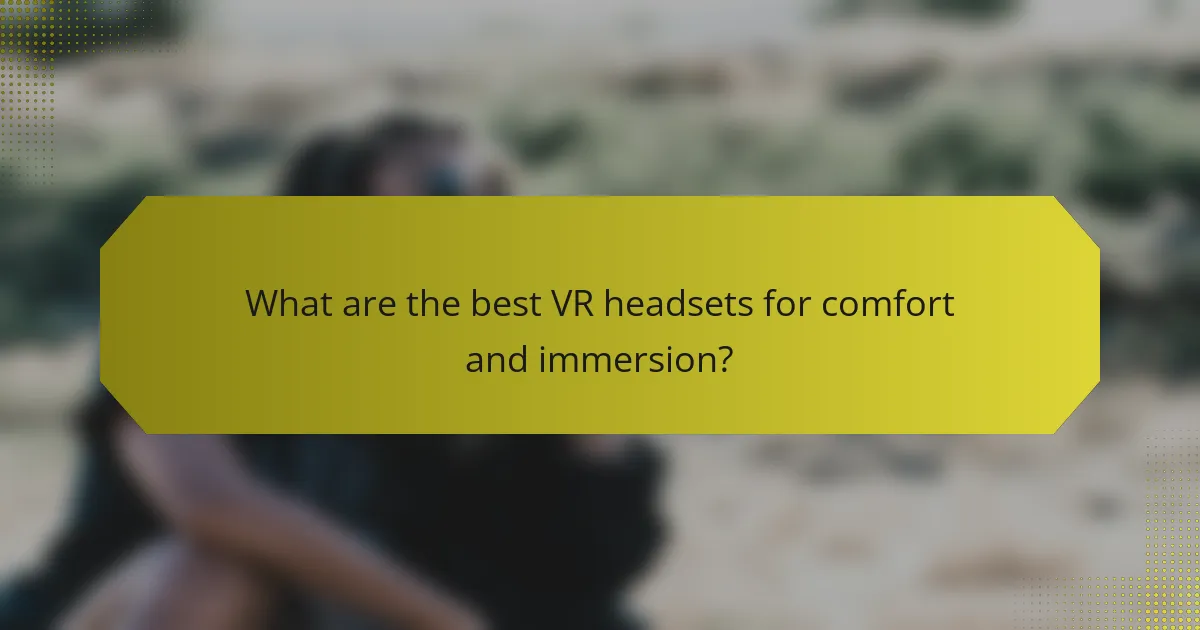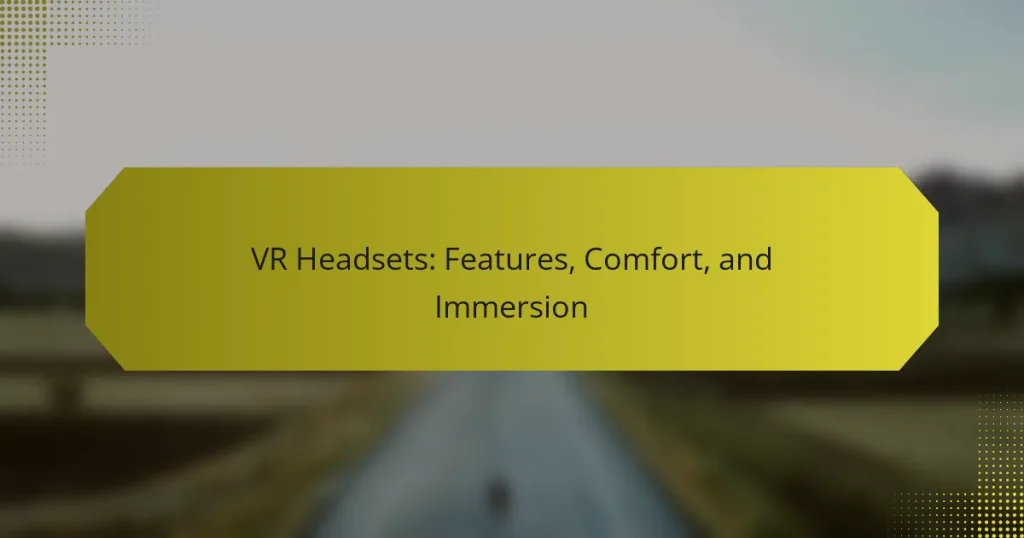Virtual reality headsets have evolved to offer unparalleled comfort and immersion, with models like the Oculus Quest 2 and Valve Index leading the way. Key features such as high resolution, wide field of view, and adjustable designs enhance user experience, allowing for extended use without discomfort. Understanding these elements is essential for anyone looking to fully engage in virtual environments.

What are the best VR headsets for comfort and immersion?
The best VR headsets for comfort and immersion include options like the Oculus Quest 2, Valve Index, HTC Vive Pro 2, and Pimax 8K X. Each headset offers unique features that enhance user experience, making them suitable for extended use and deep immersion in virtual environments.
Oculus Quest 2 features
The Oculus Quest 2 is known for its standalone capabilities, eliminating the need for a PC or external sensors. It features a high-resolution display with a refresh rate of up to 120 Hz, providing smooth visuals that enhance immersion.
Additionally, the headset is lightweight, making it comfortable for long gaming sessions. Its adjustable straps and facial interface allow for a customizable fit, which is crucial for maintaining comfort during extended use.
Valve Index comfort attributes
The Valve Index is designed with comfort in mind, featuring an adjustable head strap and a padded face gasket. This ensures a snug fit that reduces pressure points, allowing users to wear the headset for hours without discomfort.
Moreover, the Index offers a wide field of view and high refresh rates, which contribute to a more immersive experience. The finger-tracking controllers further enhance interaction, making it feel more natural and engaging.
HTC Vive Pro 2 immersion capabilities
The HTC Vive Pro 2 excels in immersion with its impressive 2448 x 2448 resolution per eye, delivering stunning visuals that make virtual worlds feel lifelike. The headset supports a wide color gamut and high dynamic range, enhancing the overall visual experience.
Its built-in audio system provides spatial sound, adding another layer of immersion. The Vive Pro 2 is also compatible with a variety of accessories, allowing users to customize their setup for optimal comfort and engagement.
Pimax 8K X field of view
The Pimax 8K X offers an extraordinary field of view, reaching up to 200 degrees, which is significantly wider than most competitors. This expansive view enhances immersion by allowing users to see more of their virtual environment without moving their heads excessively.
With dual 4K displays, the Pimax 8K X ensures sharp visuals, making it ideal for simulation games and experiences that benefit from a broad perspective. However, users should consider the need for a powerful PC to fully utilize its capabilities, as performance can vary based on hardware specifications.

How do VR headset features impact user experience?
The features of VR headsets significantly shape the user experience by affecting clarity, immersion, and overall comfort. Key aspects such as resolution, field of view, and refresh rate play crucial roles in how users perceive and interact with virtual environments.
Resolution and clarity effects
Resolution refers to the number of pixels displayed on the screen, impacting how sharp and clear the visuals appear. Higher resolutions, typically ranging from 1080p to 4K, enhance detail and reduce the visibility of pixelation, leading to a more immersive experience.
When selecting a VR headset, consider the resolution in relation to the size of the display. A headset with a lower resolution may suffice for smaller screens, but larger displays benefit from higher resolutions to maintain clarity and prevent eye strain.
Field of view importance
The field of view (FOV) determines how much of the virtual environment users can see at once, typically measured in degrees. A wider FOV, generally between 90 to 110 degrees, enhances immersion by allowing users to take in more of their surroundings without needing to turn their heads excessively.
When choosing a headset, look for one with a FOV that suits your intended use. A broader FOV can improve experiences in gaming and simulations, while a narrower FOV may be adequate for simpler applications.
Refresh rate influence on immersion
Refresh rate, measured in hertz (Hz), indicates how many times per second the image is updated on the screen. Higher refresh rates, typically ranging from 60Hz to 120Hz or more, result in smoother motion and reduce motion blur, enhancing the feeling of presence in virtual environments.
For optimal immersion, select a headset with a refresh rate of at least 90Hz, especially for fast-paced games or experiences. Lower refresh rates can lead to discomfort and motion sickness, making it crucial to prioritize this feature when making a purchase.

What are the key comfort factors in VR headsets?
Key comfort factors in VR headsets include weight distribution, padding materials, and adjustability features. These elements significantly affect the user experience, as they determine how long a user can comfortably wear the headset without discomfort or fatigue.
Weight distribution analysis
Weight distribution is crucial for comfort in VR headsets. A well-balanced headset reduces strain on the neck and face, allowing for longer usage periods. Look for headsets that distribute weight evenly across the forehead and back of the head to minimize pressure points.
Testing different headsets can help identify which models feel lighter and more balanced. Generally, headsets weighing around 500-600 grams are considered manageable for extended use, but personal preference plays a significant role.
Padding and materials used
The padding and materials of a VR headset directly influence comfort levels. High-quality foam padding can provide a snug fit while ensuring breathability, which is essential for longer sessions. Materials like memory foam or soft fabric are often preferred for their comfort and ability to conform to the user’s face.
Check for removable and washable padding, as hygiene is important, especially during shared use. Avoid headsets with hard plastic edges that can dig into the skin, leading to discomfort over time.
Adjustability features
Adjustability features enhance the fit of a VR headset, making it suitable for various head sizes and shapes. Look for models with adjustable straps, interpupillary distance (IPD) settings, and tilt options to customize the fit. A proper fit can significantly reduce discomfort and improve immersion.
Some headsets offer quick-release mechanisms for easy adjustments, which can be beneficial during long gaming sessions. Ensure that the adjustments can be made without removing the headset to maintain immersion and convenience.

How do VR headset prices vary by features?
VR headset prices fluctuate significantly based on features such as resolution, tracking capabilities, and included accessories. Generally, higher-priced models offer better immersion, comfort, and performance, making them suitable for more serious users.
Budget options under $300
Budget VR headsets typically range from $100 to $300 and are ideal for casual users or newcomers to virtual reality. These headsets often have lower resolution displays and limited tracking capabilities, which may affect the overall immersive experience.
Popular budget options include standalone devices and mobile-compatible headsets. While they provide a good introduction to VR, users should be aware that the experience may not be as rich as more expensive models.
Mid-range headsets between $300-$600
Mid-range VR headsets, priced between $300 and $600, offer a balance of quality and affordability. These devices usually feature improved resolution, better tracking, and enhanced comfort, making them suitable for more frequent use.
Examples in this category often include tethered headsets that connect to gaming PCs or standalone models with advanced features. Users can expect a significant upgrade in immersion and performance compared to budget options.
Premium headsets over $600
Premium VR headsets, costing over $600, deliver the highest quality experience with cutting-edge technology. These headsets typically boast high-resolution displays, advanced tracking systems, and ergonomic designs, catering to serious gamers and professionals.
Investing in a premium headset often means access to exclusive content and features, such as hand tracking and room-scale VR. While the price is steep, the enhanced experience justifies the investment for dedicated users.

What are the prerequisites for choosing a VR headset?
When selecting a VR headset, consider compatibility with your existing devices, minimum hardware requirements, and personal comfort preferences. These factors will significantly influence your overall experience and satisfaction with the headset.
Compatibility with gaming systems
Ensure that the VR headset you choose is compatible with your gaming system, whether it’s a PC, console, or standalone device. Popular headsets like the Oculus Quest series work independently, while others like the HTC Vive require a powerful PC.
Check the manufacturer’s specifications for supported platforms. Some headsets may offer cross-platform compatibility, allowing you to use them with multiple systems, which can enhance your gaming options.
Minimum hardware requirements
Each VR headset has specific hardware requirements that your system must meet for optimal performance. Generally, a capable graphics card, sufficient RAM (usually at least 8GB), and a compatible processor are essential.
For example, many headsets recommend a graphics card equivalent to or better than the NVIDIA GTX 1060 or AMD Radeon RX 480. Always verify the latest requirements on the manufacturer’s website to ensure your setup can handle the headset’s demands.

How does VR technology evolve for future headsets?
VR technology is evolving rapidly, focusing on enhancing user experience through improved visuals, tracking, and wireless capabilities. Future headsets are expected to offer higher resolutions, more accurate motion tracking, and seamless connectivity, making virtual experiences more immersive and accessible.
Emerging trends in VR display technology
Recent advancements in display technology are pushing the boundaries of visual fidelity in VR headsets. Manufacturers are now integrating higher resolution panels, such as 4K and even 8K displays, which significantly enhance clarity and reduce the screen-door effect.
Additionally, technologies like OLED and mini-LED are becoming more common, providing better contrast ratios and color accuracy. These improvements contribute to a more lifelike experience, making virtual environments feel more realistic and engaging.
Advancements in motion tracking
Motion tracking technology is crucial for creating immersive VR experiences, and recent developments are making it more precise and responsive. Inside-out tracking systems are gaining popularity, allowing headsets to use onboard cameras to track movement without external sensors.
Moreover, the integration of advanced algorithms and machine learning is enhancing the accuracy of motion detection, reducing latency to low tens of milliseconds. This results in smoother interactions and a more natural feel during virtual experiences.
Future of wireless VR experiences
Wireless VR is becoming increasingly viable, with advancements in Wi-Fi technology and low-latency streaming. Future headsets are expected to utilize Wi-Fi 6 and beyond, enabling high-quality graphics to be streamed without the constraints of cables.
While wireless solutions offer greater freedom of movement, users should consider battery life and potential latency issues. Manufacturers are working on optimizing power consumption and minimizing lag, aiming for seamless experiences that rival wired setups.


